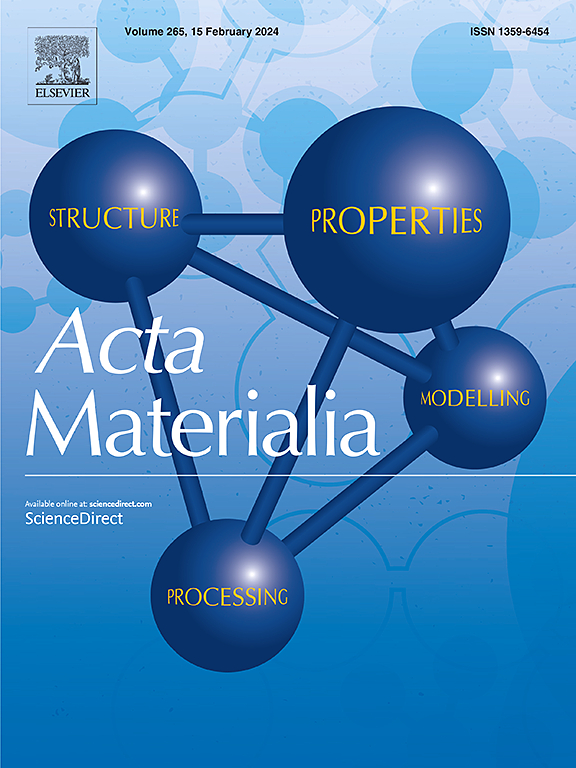Tunable and anomalous electrocaloric behaviors in Bi0.5Na0.5TiO3-based relaxor enabled by dynamics of polar nanoregions
IF 8.3
1区 材料科学
Q1 MATERIALS SCIENCE, MULTIDISCIPLINARY
引用次数: 0
Abstract
Eco-friendly electrocaloric (EC) refrigeration technology, by virtue of its high efficiency and a cutting-edge decarbonization strategy, has become a promising alternative for vapor compression refrigeration. The EC effect in Bi0.5Na0.5TiO3-based ferroelectric is prominent since their high ferroelectricity and flexible phase structure regulation. However, the underlying mechanisms responsible for high and anomalous EC performances in Bi0.5Na0.5TiO3-based ceramics are not fully addressed. In this work, a high ΔT with 0.66–0.94 K and a large temperature span (ΔTspan) of 50–60 K are achieved in Bi0.5Na0.5TiO3-Ba(Ti, Hf)O3-NaNbO3 system. The EC effect exhibits a tunable behavior, i.e., the temperature corresponds to the maximal ΔT value (ΔTmax) gradually decreases via downshifting critical freezing temperature (Tf). This phenomenon is accompanied by the collapse of domains into polar nanoregions (PNRs) and a reduction in correlation length, as supported by inverse fast Fourier transformation analysis and piezoelectric force microscopy images. Furthermore, the asymmetrical EC profiles with a large gap between exothermic and endothermic EC peaks near Tf are largely ascribed to the time effect for PNRs evolution, as demonstrated by time-resolved pulsed dielectric spectra and customized polarization test. Interestingly, high ΔT is maintained as T ≥ Tf but sharply declines as T < Tf, which originates from a crossover from activated to frozen ferroelectric state. These findings reveal that PNRs dynamics strongly impact on EC performances, with high ΔT and broad ΔTspan primarily arising from highly polar and mobile PNRs. This work not only gives a deep insight into EC behaviors in Bi0.5Na0.5TiO3-based ceramics but also proposes a refreshing strategy for optimizing EC performance with regulating PNRs dynamics.


利用极性纳米区动力学实现bi0.5 na0.5 tio3基弛豫剂的可调和异常电热行为
生态友好型电热(EC)制冷技术以其高效率和先进的脱碳策略,已成为蒸汽压缩制冷的一个有前途的替代方案。由于bi0.5 na0.5 tio3基铁电体具有高铁电性和灵活的相结构调节,其EC效应突出。然而,导致bi0.5 na0.5 tio3基陶瓷高EC性能和异常EC性能的潜在机制尚未得到充分解决。在Bi0.5Na0.5TiO3-Ba(Ti, Hf)O3-NaNbO3体系中实现了0.66-0.94 K的高ΔT和50-60 K的大温度跨度(ΔTspan)。EC效应表现出可调节的特性,即通过降低临界冻结温度(Tf),最大ΔT值(ΔTmax)对应的温度逐渐降低。这种现象伴随着畴坍缩成极性纳米区(pnr)和相关长度的减少,正如反快速傅里叶变换分析和压电力显微镜图像所支持的那样。此外,时间分辨脉冲介电光谱和定制极化测试表明,在Tf附近放热和吸热EC峰之间存在较大间隙的不对称EC分布很大程度上归因于PNRs演化的时间效应。有趣的是,当T≥Tf时,ΔT保持高位,但随着T <;Tf,它源于铁电态从激活到冻结的交叉。这些发现表明,pnr动态对EC性能有强烈影响,高ΔT和宽ΔTspan主要来自高极性和移动的pnr。这项工作不仅深入了解了bi0.5 na0.5 tio3基陶瓷的EC行为,而且提出了一种通过调节pnr动力学来优化EC性能的新策略。
本文章由计算机程序翻译,如有差异,请以英文原文为准。
求助全文
约1分钟内获得全文
求助全文
来源期刊

Acta Materialia
工程技术-材料科学:综合
CiteScore
16.10
自引率
8.50%
发文量
801
审稿时长
53 days
期刊介绍:
Acta Materialia serves as a platform for publishing full-length, original papers and commissioned overviews that contribute to a profound understanding of the correlation between the processing, structure, and properties of inorganic materials. The journal seeks papers with high impact potential or those that significantly propel the field forward. The scope includes the atomic and molecular arrangements, chemical and electronic structures, and microstructure of materials, focusing on their mechanical or functional behavior across all length scales, including nanostructures.
 求助内容:
求助内容: 应助结果提醒方式:
应助结果提醒方式:


